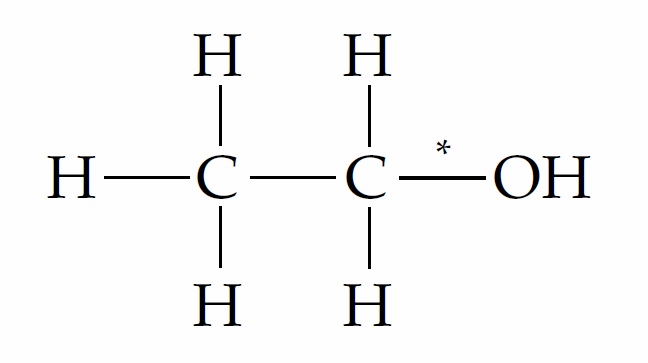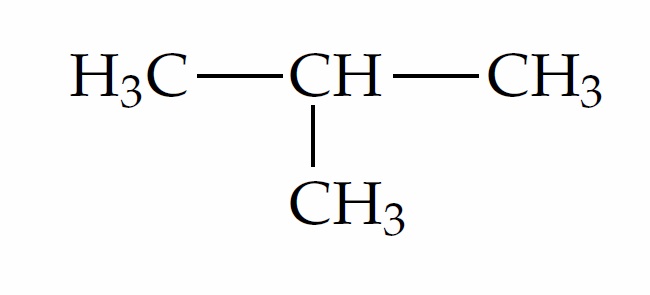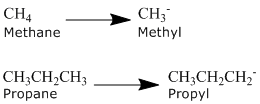3.3 Alkyl Groups
- Page ID
- 44185
Objectives
After completing this section, you should be able to
- recognize and name any alkyl group that can be considered to have been formed by the removal of a terminal hydrogen atom from a straight-chain alkane containing ten or fewer carbon atoms.
- explain what is meant by a primary, secondary, tertiary or quaternary carbon atom.
- represent the various types of organic compounds using the symbol “R” to represent any alkyl group.
Key Terms
Make certain that you can define, and use in context, each of the key terms listed below.
- alkyl group
- methyl group
- primary carbon
- quaternary carbon
- secondary carbon
- tertiary carbon
Study Notes
The differences among primary, secondary, tertiary and quaternary carbon atoms are explained in on pages 84 and 85 of the textbook. A convenient way of memorizing this classification scheme is to remember that a primary carbon atom is attached directly to only one other carbon atom, a secondary carbon atom is attached directly to two carbon atoms, and so on. As used at this point in the textbook, the term substituent might be confusing. For example, the carbon atom marked with an asterisk (*) in ethyl alcohol,

is attached to two substituents (CH3 and OH), yet it is regarded as a primary carbon atom. The definition given above makes this classification obvious: the carbon atom in question is directly bonded to only one other carbon atom. Ethyl alcohol is an example of a primary alcohol—so called because the hydroxyl group is attached to a primary carbon atom. You will find that hydrogen atoms are also classified in this manner. A hydrogen atom attached to a primary carbon atom is called a primary hydrogen; thus, isobutane, has nine primary hydrogens and one tertiary hydrogen.

The IUPAC system requires first that we have names for simple unbranched chains, as noted above, and second that we have names for simple alkyl groups that may be attached to the chains. Examples of some common alkyl groups are given in the following table. Note that the "ane" suffix is replaced by "yl" in naming groups. The symbol R is used to designate a generic (unspecified) alkyl group.
| Group | CH3– | C2H5– | CH3CH2CH2– | (CH3)2CH– | CH3CH2CH2CH2– | (CH3)2CHCH2– | CH3CH2CH(CH3)– | (CH3)3C– | R– |
| Name | Methyl | Ethyl | Propyl | Isopropyl | Butyl | Isobutyl | sec-Butyl | tert-Butyl | Alkyl |
Alkyl Groups
Alkanes can be described by the general formula CnH2n+2. An alkyl group is formed by removing one hydrogen from the alkane chain and is described by the formula CnH2n+1. The removal of this hydrogen results in a stem change from -ane to -yl. Take a look at the following examples.

The same concept can be applied to any of the straight chain alkane names provided in the table above.
| Name | Molecular Formula | Condensed Structural Formula |
|---|---|---|
| Methane | CH4 | CH4 |
| Ethane | C2H6 | CH3CH3 |
| Propane | C3H8 | CH3CH2CH3 |
| Butane | C4H10 | CH3(CH2)2CH3 |
| Pentane | C5H12 | CH3(CH2)3CH3 |
| Hexane | C6H14 | CH3(CH2)4CH3 |
| Heptane | C7H16 | CH3(CH2)5CH3 |
| Octane | C8H18 | CH3(CH2)6CH3 |
| Nonane | C9H20 | CH3(CH2)7CH3 |
| Decane | C10H22 | CH3(CH2)8CH3 |
| Undecane | C11H24 | CH3(CH2)9CH3 |
| Dodecane | C12H26 | CH3(CH2)10CH3 |
| Tridecane | C13H28 | CH3(CH2)11CH3 |
| Tetradecane | C14H30 | CH3(CH2)12CH3 |
| Pentadecane | C15H32 | CH3(CH2)13CH3 |
| Hexadecane | C16H34 | CH3(CH2)14CH3 |
| Heptadecane | C17H36 | CH3(CH2)15CH3 |
| Octadecane | C18H38 | CH3(CH2)16CH3 |
| Nonadecane | C19H40 | CH3(CH2)17CH3 |
| Eicosane | C20H42 | CH3(CH2)18CH3 |
Classification of carbon atoms
Carbons have a special terminology to describe how many other carbons they are attached to.
- Primary carbons (1o) attached to one other C atom
- Secondary carbons (2o) are attached to two other C’s
- Tertiary carbons (3o) are attached to theree other C’s
- Quaternary carbons (4o) are attached to four C's
Example 3.3.1
You will find that hydrogen atoms are also classified in this manner. A hydrogen atom attached to a primary carbon atom is called a primary hydrogen; thus, isobutane, has nine primary hydrogens and one tertiary hydrogen.
- Primary hydrogens (1o) are attached to carbons bonded to one other C atom
- Secondary hydrogens (2o) are attached to carbons bonded to two other C’s
- Tertiary hydrogens (3o) are attached to carbons bonded to three other C’s
Example 3.3.2
Contributors
Dr. Dietmar Kennepohl FCIC (Professor of Chemistry, Athabasca University)
Prof. Steven Farmer (Sonoma State University)
William Reusch, Professor Emeritus (Michigan State U.), Virtual Textbook of Organic Chemistry
Organic Chemistry With a Biological Emphasis by Tim Soderberg (University of Minnesota, Morris)

